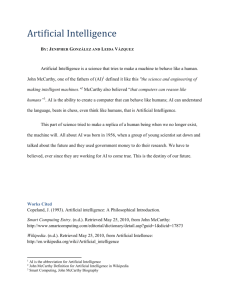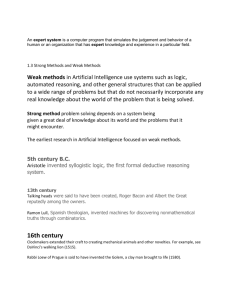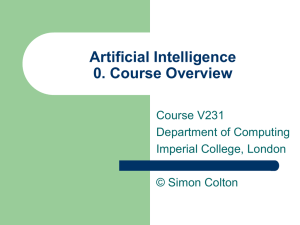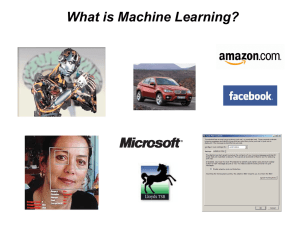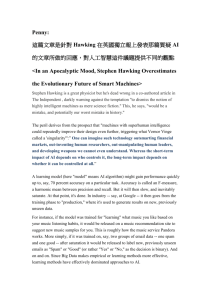MACHINE LEARNING
advertisement
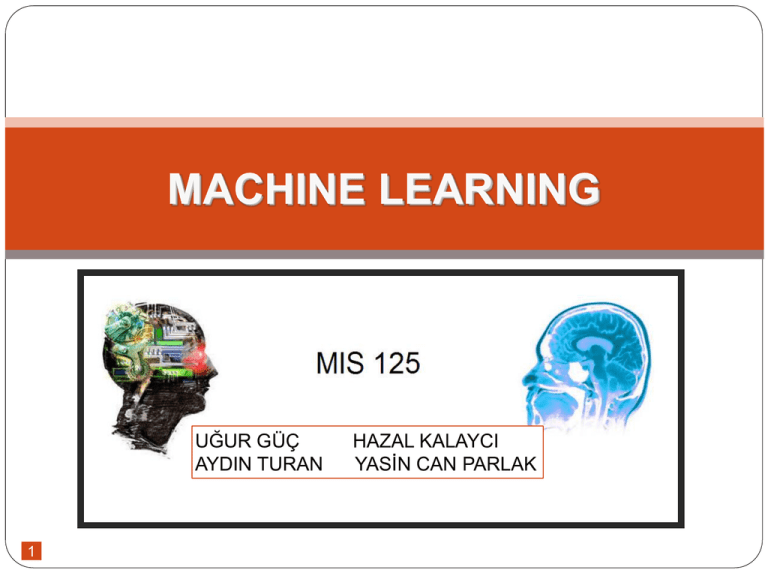
MACHINE LEARNING MIS125 Uğur Güç Hazal Kalaycı Aydın Turan Yasin Can Parlak UĞUR GÜÇ AYDIN TURAN 1 HAZAL KALAYCI YASİN CAN PARLAK Artificial Intelligence Artificial intelligence (AI) is technology and a branch of computer science that studies and develops intelligent machines and software. First AI research was founded at a conference on the campus of Dartmouth College on 1956. 2 Artificial Intelligence They wrote programs that; Solves word problems in algebra, Proves logical theorems, Speaks English. 3 Artificial Intelligence Today Human vs AI Games Robots Face Recognition 4 Advanced Search Engines Machine Learning Machine learning, a branch of artificial intelligence, concerns the construction and study of systems that can learn from data. "Field of study that gives computers the ability to learn without being explicitly programmed" ( Arthur Samuel, 1959) 5 Machine Learning -Learning to recognize spoken words (Lee, 1989; Waibel, 1989). -Learning to drive an autonomous vehicle (Pomerleau, 1989). -Learning to classify new astronomical structures (Fayyad et al., 1995). -Learning to play world-class backgammon (Tesauro 1992, 1995). 6 Machine learning also deals with representation of data instances and functions evaluated on these instances and generalization that the system will perform well on unseen data instances. It focuses on prediction based on known proporties learned from the training data. Why Machine Learning is Important? • Some tasks cannot be defined well, except by examples (e.g., recognizing people). 7 Why Machine Learning is Important? • Relationships and correlations can be hidden within large amounts of data. Machine Learning may be able to find these relationships. 8 Why Machine Learning is Important? New knowledge about tasks is constantly being discovered by humans. It may be difficult to continuously re-design systems “by hand”. The amount of knowledge available about certain tasks might be too large for explicit encoding by humans (e.g., medical diagnostic). 9 Machine Learning Machine learning deals with the problem of extracting features from data so as to solve many different predictive tasks: Forecasting (Energy demand prediction, sales) Imputing missing data (Netflix recommendations) Detecting anomalies (Virus mutations) Classifying (Canser diagnosis) Ranking (Google search) Summarizing (Social media sentiment) Decision making (Robotic, AI) 10 When to Apply Machine Learning Human expertise is absent. (Navigating on Mars) Humans are unable to explain their expertise. (Speech recognition) Solution changes with time. (Temperature control) The problem size is to vast for our limited reasoning capabilities. (Calculating webpage ranks) 11 Algorithm Types 12 Machine learning algorithms can be organized into a taxonomy based on the desired outcome of the algorithm or the type of input available during training the machine. • • • • • • Supervised Learning Unsupervised Learning Semi-Supervised Learning Transduction Reinforcement Learning Learning to Learn Approaches Decision Tree Learning 13 Approaches Association Rule Learning 14 Approaches Artificial Neural Networks 15 Approaches Support Vector Machines 16 Approaches Clustering 17 Approaches Similarity and Metric Learning 18 Approaches Representation Learning Bayesian Networks Reinforcement Learning Inductive Logic Programming 19 http://www.youtube.com/watch?v=Gj4-5W8OCAA 20 Resources http://www.cs.ubc.ca/~nando/540-2013/lectures/l1.pdf http://www.youtube.com/watch?v=w2OtwL5T1ow http://www.youtube.com/watch?v=-rMMTv7XLYw http://en.wikipedia.org/wiki/Machine_learning http://simple.wikipedia.org/wiki/Artificial_intelligence 21


